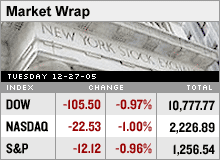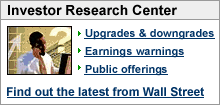|
Rough day on Street
Major gauges each lose around 1 percent as investors bail out of a slew of stocks.
NEW YORK (CNNMoney.com) - Stocks tumbled Tuesday, with investors bailing out of a variety of sectors in a broad-based end-of-the-year selloff. As of 5:30 p.m. ET, Nasdaq and S&P futures pointed to modest declines at the open Wednesday, when fair value is taken into account.
The Dow Jones industrial average (Charts), the S&P 500 (Charts) index and the Nasdaq composite (Charts) all lost around 1 percent. The losses erased the Dow's slim gains for the year and left the S&P 500 up 3.7 percent and the Nasdaq with a 2.4 percent gain, with just three full trading sessions left in 2005. Trading volume Tuesday was mild, with many Wall Streeters still on vacation after the long holiday weekend. All financial markets were closed Monday in observance of Sunday's Christmas holiday. The low volume exaggerated the downward movement Tuesday, analysts said. However, investors were also bothered by weakness in energy and tech stocks and a brief inversion of the yield curve, which revived worries about a slower economy In addition, end of the year portfolio reshuffling took a toll, said Timothy Ghriskey, chief investment officer at Solaris Asset Management. "In general, there's concern about consumer spending, but I don't think that's having much of an impact today," Ghriskey said. "And the yield curve concerns aren't new." "I really think that in this kind of environment, with such low volume, the declines you're seeing are end of year profit taking and sector reallocation by some of the larger funds." Ghriskey said that while the light volume is bound to continue through the end of the week, the trend could reverse, with portfolio managers typically reluctant to end the year with a lot of cash at hand. Wednesday brings the December consumer confidence report from the Conference Board. The index is expected to have risen to 102.5 from 98.9 in November, according to a consensus of economists surveyed by Briefing.com. Oil prices, yield curve factor
All three major gauges had risen in the first half hour of the session, as investors welcomed falling oil prices. But the drop in oil prices also took a chunk out of oil stocks, which in turn weighed on the broader market. A number of tech shares declined as well, led by Internet shares. Investors also kept an eye on the Treasury bond market, particularly after the 10-year note yield briefly fell below that of the two-year note, inverting the yield curve for the first time since 2000. Recessions followed the last two times the curve inverted, but there's been debate this year about whether an inversion is still a reliable indicator of recession. (For more, click here. For more on how the yield curve works, click here). Other than regulatory problems and an earnings warning from Guidant, there was little in the way of corporate news Tuesday, and that absence of a catalyst was part of why stocks were struggling, said John Forelli, portfolio manager at Independence Investments. As the weak wears on, "retailers will be in focus," Forelli said, "as people take a look at holiday sales and end-of-year reports." At some point, the focus may shift to earnings reports and guidance for 2006, Forelli added, as well as questions about January, a month considered an important trend-setter for yearly performance. According to the Stock Trader's Almanac, an up January tends to mean an up year and a down January tends to mean a down year. What's moving?
Market breadth was negative and volume was moderate. On the New York Stock Exchange, losers beat winners by more than eleven to five on volume of 1.15 billion shares. On the Nasdaq, decliners topped advancers by eleven to five on volume of 1.28 billion shares. U.S. light crude oil for February delivery fell 27 cents to settle at $58.16 a barrel on the New York Mercantile Exchange, recovering from a bigger decline earlier. Oil stocks fell in tandem with the price of the commodity. The Amex Oil (Charts) index lost 2.75 percent, with all 13 of its components falling, including Exxon Mobil (Research) and Valero Energy (Research). Exxon led the list of Dow 30 stocks sliding. The Dow's other big losers were American Express (Research) and Intel (Research), which both lost 2 percent. Intel was one of many chip stocks weighing on the Philadelphia Semiconductor (Charts) index, or the SOX. The SOX fell 1.3 percent. Amazon.com (Research) and eBay (Research) were among the Internet shares leading that sector lower. The Goldman Sachs Internet (Charts) index lost 1.5 percent. Ciena (Research) and ADC Telecom (Research) were among the stocks dragging down the Amex Networking (Research) index. Among other decliners, Guidant (Research) slipped after saying Friday that sales and earnings in the fourth quarter will miss forecasts, due to what the company said was consumer concern over recent malfunctions in some of its products. On Tuesday, the medical device maker announced that it had received a letter from U.S. regulators about quality control at its plant in St. Paul, Minn., where heart pacemakers are produced. The company is in the middle of a takeover struggle between Johnson & Johnson (Research) and Boston Scientific (Research). Gainers included Sirius Satellite Radio (Research), which added more than 2 percent in active Nasdaq trade after the satellite radio company said that its subscribers had topped 3 million. The dollar gained versus the euro and the yen.
COMEX gold for February delivery rose $4.90 to settle at $510.10 an ounce. |
|




